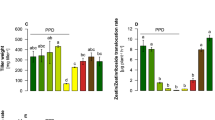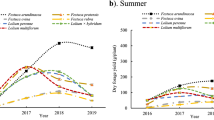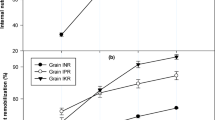Abstract
NORTH AFRICAN ecotypes of Festuca arundinacea Schreb (tall fescue) have been found capable of considerable growth during winter in Britain1. In some circumstances, during this period they have shown yellowing of foliage not seen in indigenous material. The yellowing was confined to regrowth when cold weather followed autumn or winter defoliation and was sometimes followed by death of tillers. Grobbelaar2 reported a reduced uptake of nitrate and other nutrients by maize when the root temperature was 15° C or less; Ayres and Doi3 considered that, below a soil temperature of 62° F, absorption of nutrients by sugar cane was depressed.
This is a preview of subscription content, access via your institution
Access options
Subscribe to this journal
Receive 51 print issues and online access
$199.00 per year
only $3.90 per issue
Buy this article
- Purchase on SpringerLink
- Instant access to full article PDF
Prices may be subject to local taxes which are calculated during checkout
Similar content being viewed by others
References
Green, J. O., Anslow, R. C., Corrall, A. J., and David, G. L., Grassland Res. Inst., Hurley, Exp. in Progr., 15, 12 (1963).
Grobbelaar, W. P., Meded. Landbouwhogeschool, Wageningen., 63 (1963).
Ayres, A. S., and Doi, M., Soil Sci., 96, 144 (1963).
Author information
Authors and Affiliations
Rights and permissions
About this article
Cite this article
CORRALL, A., CLEMENT, C. Uptake of Nitrate in Winter by Two Ecotypes of Festuca arundinacea Schreb. Nature 206, 109 (1965). https://doi.org/10.1038/206109a0
Issue date:
DOI: https://doi.org/10.1038/206109a0
This article is cited by
-
Aspects of the cold-hardiness mechanism in plants
The Botanical Review (1971)



